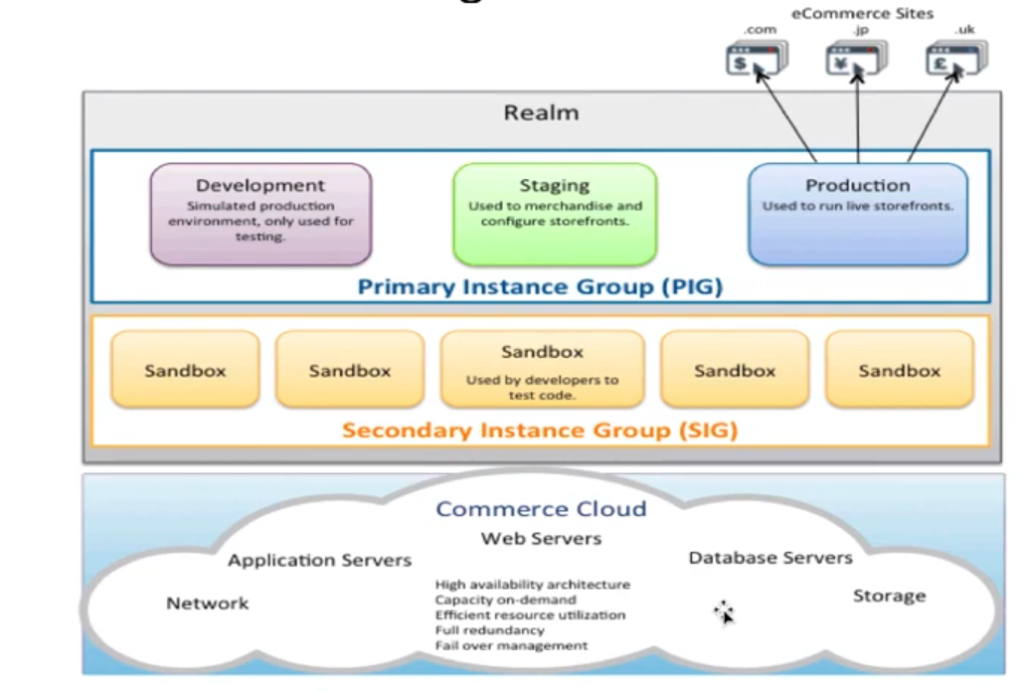Salesforce Commerce Cloud (SFCC) is a leading cloud-based e-commerce platform designed to simplify online business operations and enhance customer experiences. Originally known as Demandware, it became a part of Salesforce to offer an integrated solution combining the power of Customer Relationship Management (CRM) with e-commerce functionality. This blog provides an introduction to SFCC, its architecture, and its key components to help you get started.
What is Salesforce Commerce Cloud?
Salesforce Commerce Cloud is a robust platform that enables businesses to manage, market, and sell products seamlessly. Its advanced features, such as Artificial Intelligence (AI)-powered product recommendations, personalized customer experiences, and secure cloud-based architecture, make it a preferred choice for e-commerce enterprises.
With SFCC, businesses benefit from:
- Unified Commerce: Streamlined management of multiple storefronts and regions.
- AI Integration: Enhanced customer interactions using Einstein AI.
- Scalability: Flexible architecture that grows with your business.
- Security: High-level cloud security measures to protect data.
Architecture of Salesforce Commerce Cloud
SFCC’s architecture is designed for reliability, scalability, and ease of use. It consists of two primary layers:
| Layer | Description |
|---|---|
| Primary Instance Group (PIG) | Manages core business processes such as development, staging, and production. |
| Secondary Instance Group (SIG) | Sandboxes for testing and developing customizations before deployment. |
Primary Instance Group (PIG):
| Instance | Purpose |
|---|---|
| Development | Developers create and test features in this environment. |
| Staging | A replica of production for final testing before deployment. |
| Production | The live environment accessed by customers for real-time transactions. |
Secondary Instance Group (SIG) is primarily used by developers to build and test features, update UI, and implement new web services.

The architecture of SFCC is divided into two key layers:
- Primary Instance Group (PIG):
- Development: A dedicated space for developers to code, test, and integrate features.
- Staging: A replica of the production environment for final testing before deployment.
- Production: The live environment where the store is accessible to customers.
- Secondary Instance Group (SIG):
- Used for sandbox environments where developers can create customizations, UI updates, and web services before final deployment.
This high-availability cloud architecture ensures seamless operations and secure transactions.
Business Manager Overview
The Business Manager is the administrative interface of SFCC. It provides tools to manage all aspects of an e-commerce store. Here’s a breakdown of its key sections:
- Merchant Tools:
- Content Management: Handle static and dynamic content, create customer profiles, and import/export customer data.
- Custom Objects: Store and manage data using a database-like structure.
- Products & Catalogs: Configure product details, pricing, and catalogs.
- Search Settings: Optimize search results with stop keywords, suggestions, and synonyms.
- Online Marketing: Manage campaigns, promotions, and coupons.
- Administration:
- Create user roles, set permissions, and configure FTP connections.
- Manage store-specific settings and security preferences.
- Operations:
- Schedule tasks, create cron jobs, and manage data import/export.
- Implement geolocation settings for localized services.
- Storefront:
- Access the live view of your store to see real-time updates and test functionality.
Development with Eclipse and UX Studio
To customize and develop on SFCC, Salesforce provides the UX Studio plugin for Eclipse. This tool allows developers to create and manage cartridges, which are modular structures containing code, configurations, and assets.
Steps to Set Up UX Studio:
- Install Eclipse Mars or Neon: Ensure compatibility with UX Studio.
- Download UX Studio Plugin: Use the provided URL to add the plugin via Eclipse’s “Install New Software” option.
- Connect to a Digital Server: Set up a new digital server connection using your SFCC credentials.
- Start Development: Create new cartridges to customize storefronts or extend business manager functionality.
Cartridges form the backbone of SFCC customization, enabling developers to add features such as custom product pages, API integrations, and user interface enhancements.
Key Features of Salesforce Commerce Cloud
| Feature | Description |
|---|
| Multi-Region Support | Manage multiple stores for different regions under a unified platform. |
| Integrated Marketing | Tools for managing SEO, promotions, and campaigns. |
| Customizable Workflows | Automate business processes with flow templates. |
| Real-Time Recommendations | Provide AI-driven product suggestions to enhance user experience. |
| Scalability and Security | Grow your business without compromising on security or performance. |
Why Choose Salesforce Commerce Cloud?
- Enhanced User Experience: Tailored recommendations and seamless navigation.
- Developer-Friendly Environment: Comprehensive tools for coding, testing, and deployment.
- End-to-End Solution: Manage everything from inventory to customer support in one place.
- High Security Standards: Salesforce’s robust cloud infrastructure ensures data safety.
Conclusion
Salesforce Commerce Cloud is a comprehensive platform designed to empower e-commerce businesses with cutting-edge tools and technologies. From its high-availability architecture to advanced development capabilities, SFCC offers everything you need to build, manage, and grow your online store.
In upcoming posts, we’ll delve deeper into individual features, such as managing catalogs, configuring Business Manager tools, and customizing storefronts with cartridges. Stay tuned, and don’t forget to subscribe for more insights into Salesforce Commerce Cloud!